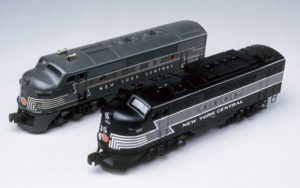
WILLIAMS ELECTRIC TRAINS continues to field unique, detailed locomotives that are, in the words of the retail trade, “priced to move.” The latest two engines from the Columbia, Md., firm are an Alco FA and an EMD BL2.
Both locomotives come from the electrifying days when the direction diesel motive power would take was still undecided and just about any manufacturer could have walked away with the golden ring.
The Alco FA-1
Between 1946 and 1950, more than 400 1,500-horsepower Alco DL-208s (or FA-1s) were sold to 21 railroads. The Alco FA shared its squared-off snout design with its much more glamorous sister, the legendary PA.
The turbocharged FA used the Alco 244-series prime mover, which could be problematic, but it also had an Amplidyne control system that equated to “power now” when the engineer needed it. Engineers may have liked it, but some maintenance crews had other thoughts.
As happened to many locomotives offered by smaller diesel builders, Alco ultimately couldn’t compete with the onslaught by EMD and the standardization and reliability of its products. Nevertheless, more than 1,200 A and B units of all versions of the Alco cab units (FA-1, -2, and FP) were sold to North American railroads.
The FA has been a toy train staple since 1950. The locomotive, most often in a smaller O-27 version, has been offered by Kusan, K-Line, Lionel, MTH, Weaver, and now Williams. This latest entry is an excellent rendition of the classic Alco.
This model offers terrific value for the operator. The locomotive shell features see-through etched metal side grills and a see-through rooftop grill with simulated fan blades cast into the screen. The engine has separately applied grab irons along the sides of the cab, on the nose, above the split windshield, and even at the rear of the unit.
The model also has an illuminated headlight, illuminated marker lights next to illuminated number boards, a die-cast metal fuel tank, and die-cast GE-motor versions of the ARA type-B road truck, correct for the Alco.
The engine is fairly hefty, not too light, not too heavy, but just right. Williams’ FA measures 13 inches in length (52 feet in O scale) compared to a prototype A unit’s 51 feet, 6 inches. The powered unit of the duo weighs in at a solid 4 pounds, 5 ounces.
The FA-1 uses the new Williams True Blast digital horn. The horn sound is pretty neat. It is realistic and, although basic, still a quantum leap ahead of the standard electric “doorbell buzzer” found on many other locomotives.
CTT saw both the Lehigh Valley and New York Central models and found the painting to be top notch. The shell includes minute nomenclature items, such as an builder’s plate and Lehigh Valley class lettering.
The EMD BL2
If James Dean has been a railroader, he would have driven a BL2. And he would have been a rebel with a cause!
The BL2 is a crazy-looking 1,500-horsepower diesel briefly offered by General Motors’ Electro-Motive Division in 1948-49. The styling evokes the days when two-ton cars with fins and portholes ruled America’s highways. The unique bi-directional cab, the sloping rear, and the gently rolling arch along the nose suggest a Buick or Oldsmobile more than a locomotive.
The diesel was intended for light-traffic branch lines (hence the letters BL). The streamlined body evokes the image of some sort of F unit, but the better rear visibility offers the functionality of a road switcher. The engine is the bridge design between cab and hood units. The BL2, however, turned out to be too eccentric a design for America’s railroads, and a mere 58 units were sold. Seven of 58 are still in existence in six states, and two are believed operational.
The Williams’ model is a Phase I BL2. While the engine’s detailing is a bit less intricate than the FA, (no see-through screens on this model), it looks fine and has two physical features worth noting: exceptionally smooth tooling (especially in light of the sloping sides) and shaped metal handrails rather than the expected stamped-steel handrails common on Williams diesels. Looking at prototype photos and diagrams, this Williams model appears to be a faithful rendition of the prototype.
The model measures 13 inches long (52 feet in O scale) compared to the prototype’s 54 feet, and weighs 4 pounds, 5 ounces.
The paint on our sample was nicely applied and is especially commendable considering the complexity of the old Florida East Coast paint scheme.
The Williams BL2 is a distinctive diesel with a rakish body that may not appeal to everyone. But if you like sleek trains and perhaps fuzzy dice hanging from your mirror, you may find yourself wanting to run the BL2 at the head of every train in your fleet.
FA/BL2 performance
Under the hood, the two engines are the same. These engines are designed for operation on curves as tight as O-27. On a layout both the BL2 and FA were fun to run and looked good. Each engine easily handled our 20-plus car test train and seemed to have the ability to give a little more speed and power whenever needed.
Motors were quiet in all speed ranges and quick to respond to transformer commands. Flywheels allowed both engines to coast nicely to a stop. Both of these two-motored locomotives required very little time to break in and delivered similar performance numbers compared to our benchmark locomotive, a postwar two-motored F3. The FA’s low-speed average was 16.8 scale mph, and the high-end average was 96.2 scale mph. The BL2’s low-speed average was 15 scale mph and the high-speed average was 98.6 scale mph.
Both engines out pulled our benchmark F3, with each measuring 2 pounds, 8 ounces, equal to approximately 120 modern, free-rolling pieces of rolling stock. Both of these locomotives are carefully designed, look good on the point of a train, perform well, and are quite a value for the dollar.
Whether or not you operate your railroad on a tight budget, these new locomotives from Williams are worth a closer look.














Joshua Lionel WHO?
Great value and quality from Williams.I picked up the Bangor and Arostook EP-2 and love it.I have a photo of a real new EP-2 Bangor taken in 1948 next to a GP7.To find a model of this cool little diesel is great.Nice job Wilimas/Bachmann.
The Williams scale Alco FA-1 out of the box had an electrical short when placed on the track for the first time. I removed the shell and quickly found a wire that had been pinched, breaking the insulation and exposing bare wire. A quick fix with some electrical tape had the locomotive running perfectly. The Rock Island Alco FA-1 is superbly detailed with crisp and clean lettering and striping. The scale dimensions and detailing make it much more realistic than the Lionel FAs I received for Christmas in 1954. Williams produces great value.
I bought a BL2 in BAR colors in 2005. It has over 800 hours on it. on weekends it will run 8-10 hours non-stop. No problems at all. Highly reccomend this product.
I have a set of Pennsy FAs and a C&O BL2 and they both run flawlessly. I purchased them over 3 years ago and have had no problems.
Bob Schulz (10-6-2009)
I used my Rock Island BL2 to pull a set of threee heavyweight passenger cars around the Christmas tree. It was a real hit, with no malfunction at all.
Just purchased my sixth williams diesel. And this time it was the Lehigh and New England FA-1. What a beauty and a "BRUTE". I just love these engines!!
I never had a problem with any of them.